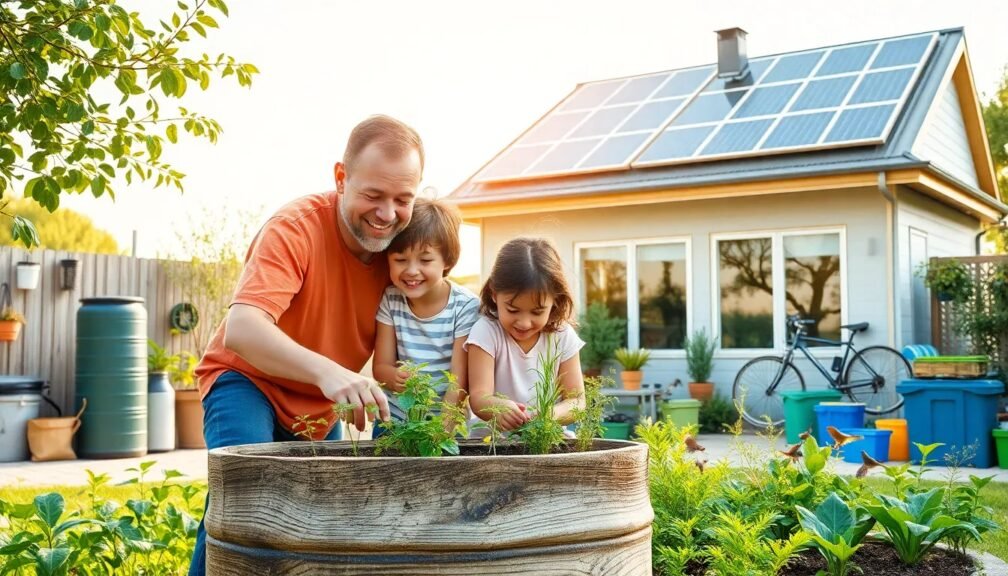In today’s fast-paced world, the urgency of adopting sustainable living practices is more critical than ever. As individuals, we possess the power to influence our environment—transforming our homes into eco-friendly havens. In this article, we’ll explore 10 easy tips for sustainable living that can significantly reduce your carbon footprint. Embracing green home solutions not only benefits the planet but also enhances the quality of our lives. Let’s dive into practical ways to make your home greener and more efficient.
Understanding Green Home Solutions
Before we delve into specific tips, let’s clarify what green home solutions are. These practices encompass a variety of methods and avenues aimed at reducing environmental impact. This can include energy efficiency, water conservation, waste reduction, and the use of sustainable materials. By implementing these solutions, homeowners can contribute to a healthier planet while also enjoying the benefits of lower utility bills and a more habitable space.
1. Embrace Renewable Energy
One of the most important green home solutions is the utilization of renewable energy sources, such as solar or wind power. Installing solar panels on your roof can drastically reduce your dependence on fossil fuels and significantly lower your electricity bill. Many governments offer incentives for solar installations, making it more affordable than ever.
Why It Matters
Switching to renewable energy not only reduces greenhouse gas emissions but can also increase the value of your home. More buyers are seeking energy-efficient homes with renewable energy systems.
2. Enhance Energy Efficiency
Incorporating energy-efficient appliances is another easy green home solution. Look for ENERGY STAR-rated appliances, which use less energy and water compared to conventional models.
Simple Upgrades
- Replace incandescent light bulbs with LED versions.
- Use smart power strips to minimize phantom energy use by shutting off power to devices when not in use.
By making these upgrades, you can lower your utility bills and reduce your overall energy consumption.
3. Optimize Insulation and Sealing
Effective insulation and sealing of your home can drastically decrease the need for heating and cooling. Ensuring that windows and doors are properly sealed prevents costly energy loss.
DIY Tips
- Use weather stripping around windows and doors.
- Insulate attics, basements, and crawl spaces with sustainable materials.
Enhancing your home’s insulation can lead to significant energy savings and create a more comfortable living environment.
4. Water Conservation Strategies
Water is a precious resource, and adopting water conservation tactics can greatly contribute to sustainable living. Simple adjustments can make a significant impact.
Practical Steps
- Install low-flow faucets and showerheads to reduce water use.
- Collect rainwater in barrels for irrigation.
These simple changes not only conserve water but also help lower your water bill.
5. Choose Sustainable Materials
When remodeling or redecorating, opt for sustainable materials that have a lower ecological impact. This includes bamboo flooring, recycled glass countertops, and organic fabrics.
Benefits of Sustainable Materials
- Bamboo is rapid-growing and requires less water than hardwood.
- Recycled materials reduce waste in landfills and lessen the demand for new resources.
By selecting sustainable materials, you create a healthier indoor environment and support eco-friendly practices.
6. Shift to Non-Toxic Cleaning Products
Many household cleaning products contain harmful chemicals that can affect air quality and are dangerous for the environment. Switching to non-toxic cleaning options is a simple way to promote a green home.
Natural Alternatives
- Vinegar and baking soda can be powerful cleaners and degreasers.
- Essential oils can provide pleasant scents without harmful side effects.
Choosing eco-friendly cleaning solutions helps protect your health and that of the planet.
7. Composting
Composting is not only a great way to manage organic waste but also a beneficial practice for enriching garden soil. By composting kitchen scraps and yard waste, you’ll divert a significant amount of waste from landfills.
How to Start Composting
- Choose a compost bin or simply designate a space in your yard.
- Add a mixture of greens (nitrogen-rich) and browns (carbon-rich) for the best results.
Composting enriches your garden, reduces waste, and promotes a sustainable lifestyle.
8. Grow Your Own Food
Cultivating your own fruits, vegetables, or herbs is one of the most fulfilling green home solutions. Whether you have a backyard or a balcony, you can grow your own food and reduce your reliance on store-bought produce.
Container Gardening
If you’re short on space, consider container gardening. Window boxes or vertical gardens can maximize your growing area while providing fresh produce.
Growing your own food reduces your carbon footprint associated with food transportation and packaging.
9. Reduce, Reuse, Recycle
The three R’s—reduce, reuse, and recycle—are cornerstone principles of sustainable living. Minimizing waste not only helps the environment but also encourages mindful consumption.
Actionable Tips
- Reduce: Be mindful when purchasing; consider whether you really need an item before buying.
- Reuse: Look for ways to repurpose old items instead of discarding them.
- Recycle: Familiarize yourself with local recycling guidelines to ensure your materials are disposed of correctly.
Incorporating these principles into your daily life can lead to substantial waste reduction.
10. Smart Transportation Choices
Finally, being mindful of how you get around can also be part of your green home solutions. Opting for public transport, carpooling, or investing in an electric vehicle are all sustainable choices that can dramatically cut down on emissions.
Tips for Smart Transportation
- Biking or walking for short trips reduces fuel consumption and improves your health.
- Explore car-sharing services that minimize the number of vehicles on the road.
Making conscious transportation choices contributes significantly to creating a greener community.
Conclusion: Take Action for a Sustainable Future
Adopting these green home solutions is not just about saving the environment—it’s about enhancing your living space and benefiting your health. Implementing these tips can lead to immediate savings, both financially and environmentally.
Remember, every small change contributes to a larger impact. Start with one or two tips that resonate with you and gradually incorporate more as you feel comfortable. Together, we can create a more sustainable future—one home at a time.
Actionable Insights
- Assess your home’s energy efficiency today.
- Begin composting this week.
- Evaluate your current cleaning products and consider safe alternatives.
Every action counts. The journey to sustainable living begins with you!



